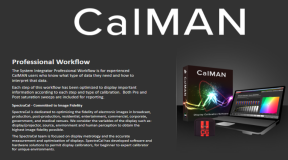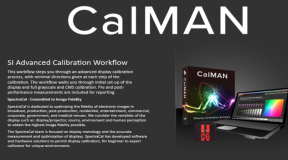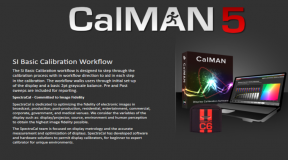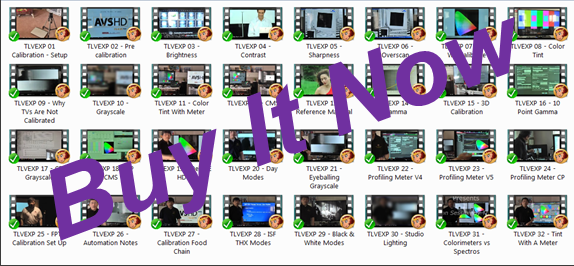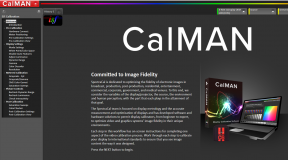With the cost of flat panel displays and projectors dropping well south of the $1000 mark these days … I start to wonder about that market place and how it pertains to professional calibration. I just saw an LG 60″ plasma going for $899 on a boxing day sale. Is there a market for those that buy the budget displays? Budget does not mean poor quality any more.
In the early days of calibration back in the year 2000 or so, most clients seeking out professional calibration had just spent $2000 to $10000 on a HD rear projection tv and they all needed some measure of tweaking out if only to account for the rigors of what truck shipping did to the unit and moving those giant monoliths down into basements or up into lofts and bonus rooms. There were always TVs on the market that were in the $1000 and less range, but often enough, they were not even HDTVs. There were still plenty of $1000 RPTVs that were still only standard definition. Could they have benefited from professional calibration? Absolutely.
The general consensus was that people that bought $1000 tvs were not in the market for quality and bought simply what they could afford. They would not be candidates for the professional calibrator. Most calibration jobs on RPTVs still took up to 6 hours and the charge was typically $350 to $600. People who buy $1000 tvs could not justify spending another 35% to 50% of the price of the TV on a calibrator. As things turned out, the consensus was correct. I rarely got any inquiries from people in the sub $1000 price point.
Don’t forget that a lot of people will pay vast amounts of money for things … material goods, but simply refuse to pay any money for something like a service. There is a certain mindset that would never pay for a professional calibration, and never want to learn it themselves, but will still pursue better performance by buying their way out of any problem. Buy another TV … and keep buying until they get one that can satisfy them as being good enough … or the best of the best in their own mind.
The funny thing about this approach versus paying for some calibration experience is that cost of calibration on an existing TV could always give them equivalent if not better performance than their next tv that will be at twice the price. A $400 calibration job on a $2000 RPTV easily gave the display the performance of any uncalibrated $4000 display. (A calibrated $4000 display would be better still of course.) But so many people still don’t think like that and are certain they can buy their way out of any hole.
The dilemma back then and still today is a question of cost effectiveness. In terms of time, it takes the same amount of time and effort to work on a $1000 46″ LG 3D set as it does on a $5000 55″ LG 3D set. The test equipment is still the same and that still has to be maintained. The amount of research needed on any particular set is still the same. Professional calibration won’t add features to an inexpensive set like local dimming or edge dimming. That is how the TVs differentiate themselves now … more features and thinner as the price goes up. The black levels also improve because the lighting technology changes from budget lines to top of the line.
So if it takes the calibrator the same four to six hours to calibrate the $1000 tv, his effort is the same and his overhead costs are still the same so it just makes sense that his charge would still be the same. Pleading oneself as a hardship case might get the cost reduced, but if the calibrator sees that the hardship case lives in a better home than he does …
The best calibrators out there all have tailored their service to include a large education component to the process. The premise is that calibrated images mean nothing if the person does not understand why it is what it is. Answers without understanding are answers without meaning. (For more on this, read the article about the man with the baseball bat in Hit and Run Calibration.)
The calibration still takes the four plus hours because the education easily takes 60% of the entire process.
So for the sake of discounting to try to include those in the under $1000 crowd, the education could be omitted from the process. That brings the client the same end result as the full service and more than halves the time spent in the client’s home. Both parties should be happy with such an arrangement, but this approach opens up our calibrator to the consequences of not educating the client. For the sake of a quick $200 payday on an $800 tv calibration, the calibrator may now have to deal with a number of calibration questions on the back end. Why does the picture look like this? Why is vivid mode brighter? The original picture looked better. Why does the graph not look perfect? … and it doesn’t end here.
The worst of it is that any answer you give to this client on the back end is simply in one ear and out the other. He is not listening to you since he has convinced himself that you did a substandard job. He will get satisfaction from you because the alternative is that he will go onto the internet and tell everyone how bad you are as a calibrator. He can do a lot of harm to your reputation all over you wanting a quick $200 and doing him a massive favor. He won’t be seeing it this way … and you have a mess on your hands.
The only way to fix this is to go back to his home and sit him down for 2+ hours and give him the education … or you refund his $200 and hope he goes away, but the damage is more than done.
So does that mean that discounted calibrations are out of the question? I don’t think so. If calibrators approach things with a Priceline type mentality, they can accept the offer to pay anything they want … but they might treat the occasion as more of a practice session than the real deal just to keep themselves sharp. I’ve sometimes said that if the difference is between an evening of sitting at home and earning nothing versus some cash, it might be worthwhile to take the job. The calibrator still has to weight the cost benefit of this himself. Sometimes a good will gesture might lead to other opportunities down the road. Sitting at home usually doesn’t.
Enthusiasts that buy the budget displays can still follow the DIY route, but they will quickly discover that nothing is free and accuracy comes at a cost. They may go with free software, but the hardware will still set them back at least $200 and of course accuracy is very questionable at this price point. Is it going to be better than nothing? That really depends on the probe itself because some of them give very wrong answers. On those probes, the preset movie mode in the tv may actually be a better choice than even trying the entry level stuff.
For myself, it comes down to whether or not I will feel like doing it for the reduced rate. My quotes would always be based on the normal rates, but additional TVs usually bring additional discounting anyway. I might also go with by back up meter, the i1 Pro in some cases and the clients would not be getting the THX plaque as a result of this. Of course as a professional calibrator, if you followed our advice in the class to not quit your day job, then you might not find yourself in a bind to get $150 or so at any cost.

